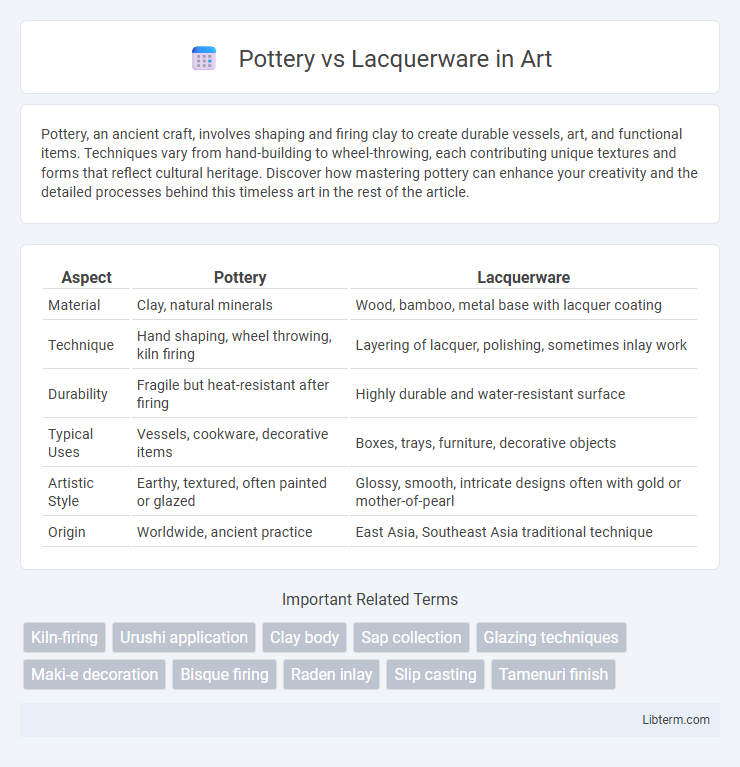Pottery, an ancient craft, involves shaping and firing clay to create durable vessels, art, and functional items. Techniques vary from hand-building to wheel-throwing, each contributing unique textures and forms that reflect cultural heritage. Discover how mastering pottery can enhance your creativity and the detailed processes behind this timeless art in the rest of the article.
Table of Comparison
| Aspect | Pottery | Lacquerware |
|---|---|---|
| Material | Clay, natural minerals | Wood, bamboo, metal base with lacquer coating |
| Technique | Hand shaping, wheel throwing, kiln firing | Layering of lacquer, polishing, sometimes inlay work |
| Durability | Fragile but heat-resistant after firing | Highly durable and water-resistant surface |
| Typical Uses | Vessels, cookware, decorative items | Boxes, trays, furniture, decorative objects |
| Artistic Style | Earthy, textured, often painted or glazed | Glossy, smooth, intricate designs often with gold or mother-of-pearl |
| Origin | Worldwide, ancient practice | East Asia, Southeast Asia traditional technique |
Introduction to Pottery and Lacquerware
Pottery is a traditional craft involving shaping and firing clay to create durable ceramic objects, often decorated with glazes or painted designs. Lacquerware involves applying multiple layers of resin derived from the lacquer tree onto wood or other materials, producing a glossy, protective coating often embellished with intricate paintings or inlays. Both crafts showcase distinct cultural artistry and techniques, reflecting their origins and functional uses in everyday life.
Historical Origins and Development
Pottery originated around 10,000 BCE during the Neolithic period, primarily used for storing food and water, with early examples found in regions like the Middle East and East Asia. Lacquerware dates back to around 7,000 BCE in East Asia, especially China and Japan, where resin from lacquer trees was applied to wooden or bamboo objects to create durable, decorative surfaces. The development of pottery emphasized functional vessel shapes and firing techniques, whereas lacquerware evolved through intricate layering and polishing processes, reflecting distinct cultural aesthetics and technological advances.
Materials Used in Pottery and Lacquerware
Pottery is primarily crafted from natural clay that is shaped and fired at high temperatures to achieve durability and aesthetic appeal, with common materials including earthenware, stoneware, and porcelain. Lacquerware is made by applying multiple layers of sap from the lacquer tree (Toxicodendron vernicifluum) onto wood, bamboo, metal, or leather substrates, creating a highly polished, durable surface resistant to moisture and heat. The fundamental difference lies in pottery's reliance on mineral-based clay, while lacquerware depends on organic sap coatings over diverse base materials.
Crafting Techniques and Processes
Pottery involves shaping and firing clay in a kiln, utilizing techniques like wheel throwing, hand-building, and glazing to create durable ceramic items. Lacquerware requires applying multiple layers of lacquer, derived from the sap of the lacquer tree, onto wood or metal objects, each layer meticulously polished to achieve a smooth, glossy finish. The contrasting processes highlight pottery's reliance on high-temperature firing for hardness, while lacquerware emphasizes skilled surface treatment and layering for decorative resilience.
Artistic Styles and Cultural Significance
Pottery showcases a diverse range of artistic styles characterized by hand-molded clay forms, often decorated with intricate glazes and traditional motifs that reflect regional histories and rituals. Lacquerware is distinguished by its glossy, layered coating technique using resin from lacquer trees, creating vibrant, durable surfaces adorned with detailed inlays and often symbolic imagery tied to spiritual and societal values. Both crafts hold profound cultural significance as expressions of identity, craftsmanship, and heritage, preserving ancestral techniques and aesthetic philosophies within their respective communities.
Durability and Functional Uses
Pottery exhibits strong durability against heat and is ideal for cooking and serving hot foods, while lacquerware offers superior resistance to moisture and corrosion, making it well-suited for decorative storage and serving utensils. Pottery's porous nature requires glazing to prevent liquid absorption, whereas lacquerware's smooth, non-porous surface provides easy cleaning and longevity in humid environments. Both materials serve functional roles based on their durability traits: pottery excels in practical kitchenware, and lacquerware is preferred for elegant, moisture-resistant containers and ornamental objects.
Maintenance and Care Differences
Pottery requires careful handling to avoid chipping or cracking and should be cleaned with mild soap and water, avoiding sudden temperature changes to prevent damage. Lacquerware demands delicate maintenance, typically cleaned with a soft cloth and mild detergent, avoiding abrasive materials and prolonged exposure to sunlight or moisture that can cause fading or peeling. Proper storage for pottery involves cushioning to prevent breakage while lacquerware benefits from a dry, shaded environment to maintain its glossy finish.
Environmental Impact and Sustainability
Pottery production primarily involves natural materials like clay and water, which are abundant and biodegradable, but firing pottery requires high energy consumption, contributing to carbon emissions. Lacquerware uses natural resin harvested from trees, a renewable resource that supports sustainable forestry practices, though the labor-intensive process can limit scalability. Both crafts promote eco-friendly artisanal techniques, but sustainable sourcing and energy-efficient methods are critical to minimizing their environmental footprint.
Popular Pottery and Lacquerware Regions
Japan's popular pottery regions include Arita, known for its fine porcelain, and Seto, famous for its ceramics production dating back to the 13th century. In contrast, lacquerware flourishes in Wajima, celebrated for its durable and intricate urushi lacquer designs, and in Hakone, recognized for its unique techniques and elegant appearance. Both crafts reflect regional traditions, with pottery emphasizing kiln-fired clay artistry and lacquerware showcasing layered, polished finishes from natural sap.
Buying Tips: Choosing Between Pottery and Lacquerware
When choosing between pottery and lacquerware, consider durability and maintenance; pottery is porous and can chip but is microwave safe, while lacquerware is lightweight and water-resistant but sensitive to heat. Evaluate your kitchen or decor style preferences, as pottery offers a rustic, earthy aesthetic, whereas lacquerware provides a glossy, elegant finish. Prioritize the function of the item--pottery excels for everyday use, and lacquerware is ideal for decorative or formal occasions.
Pottery Infographic

 libterm.com
libterm.com